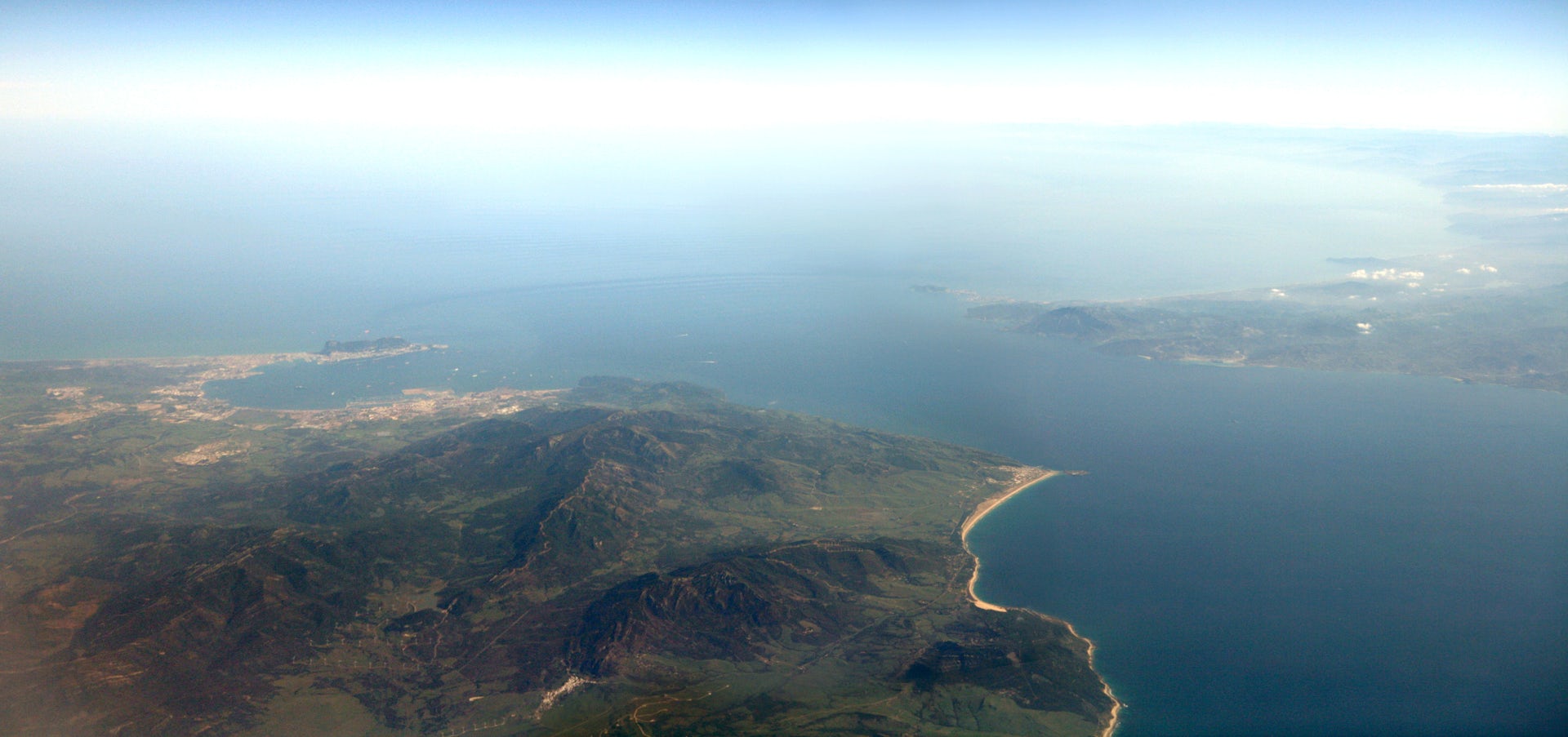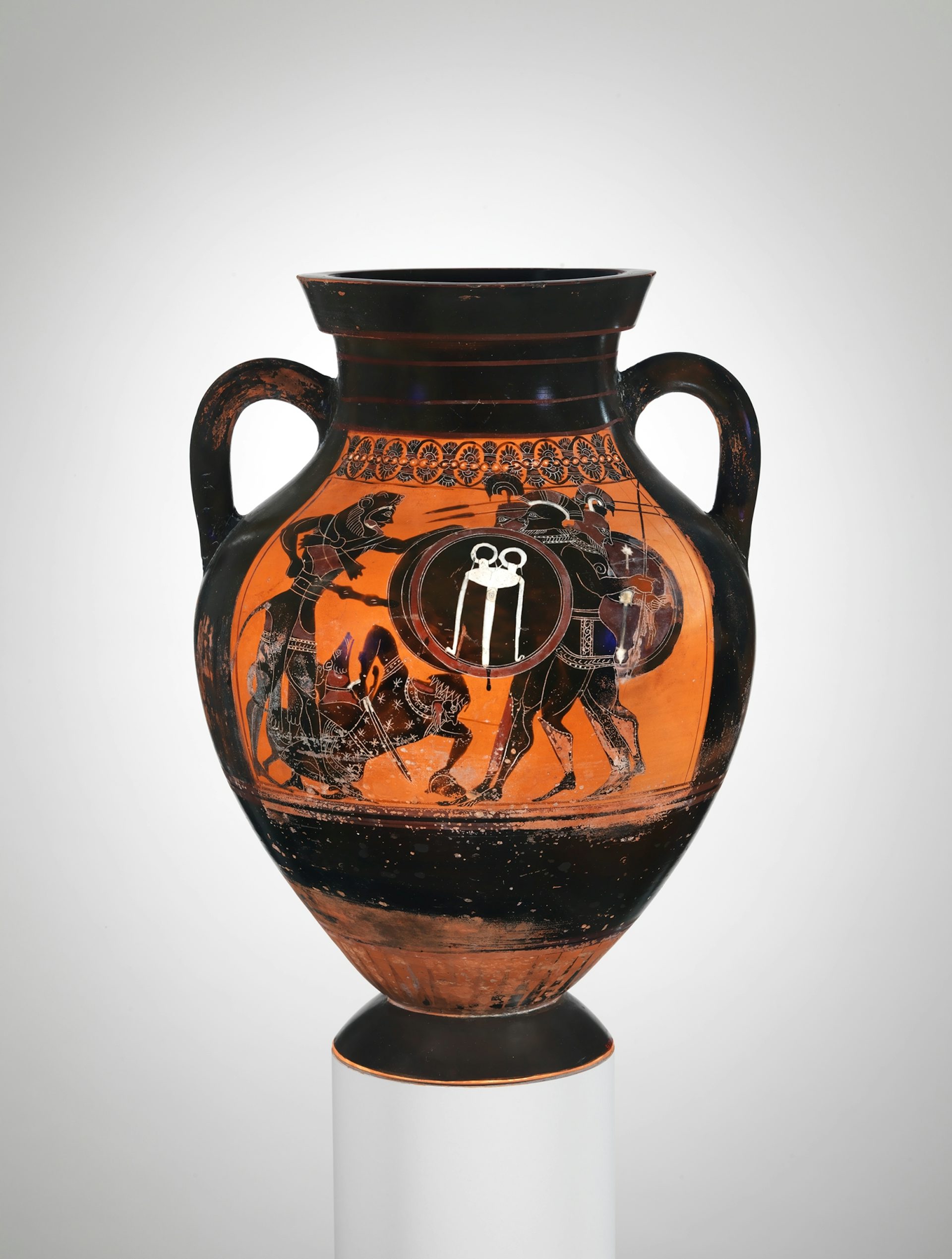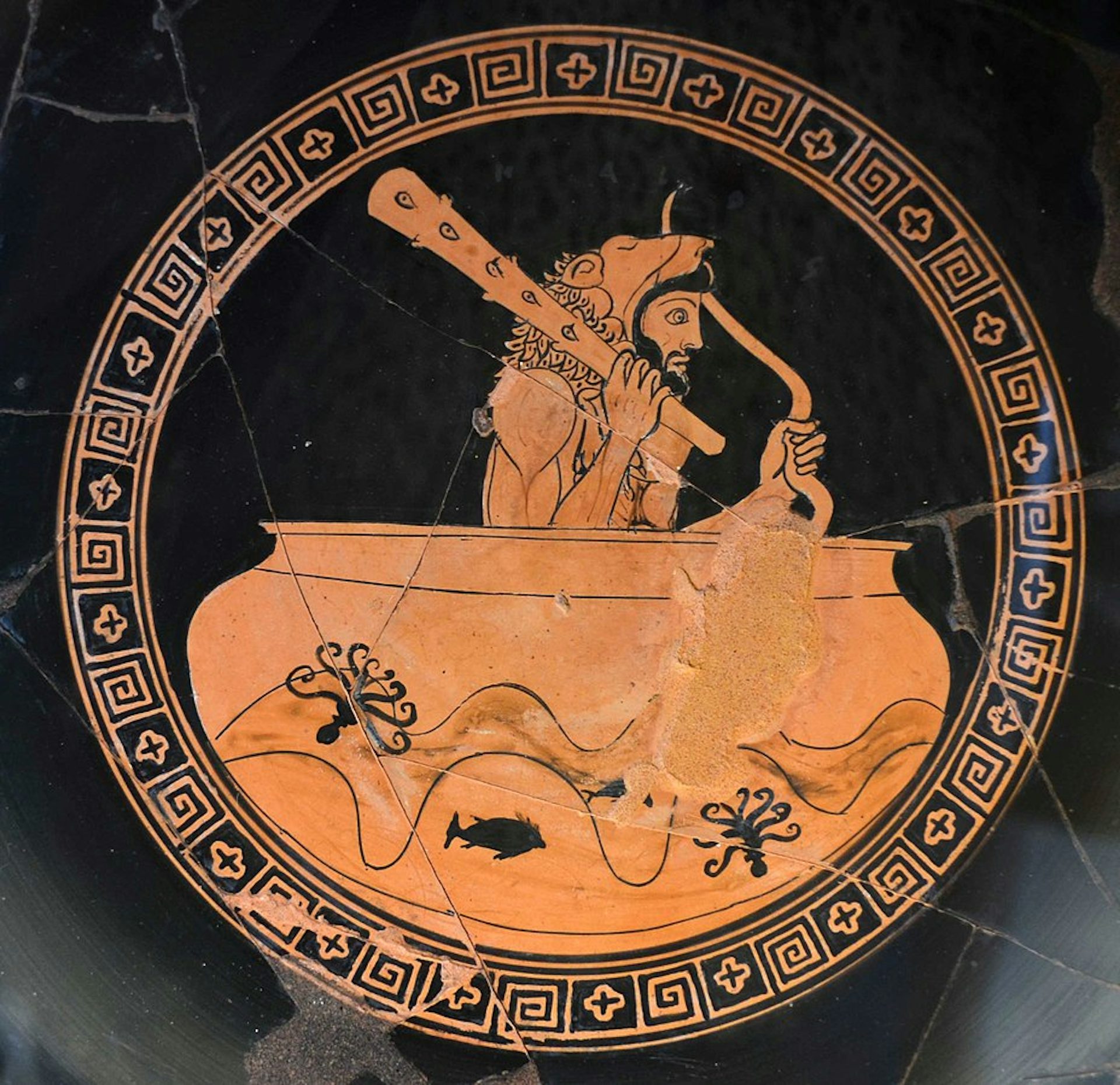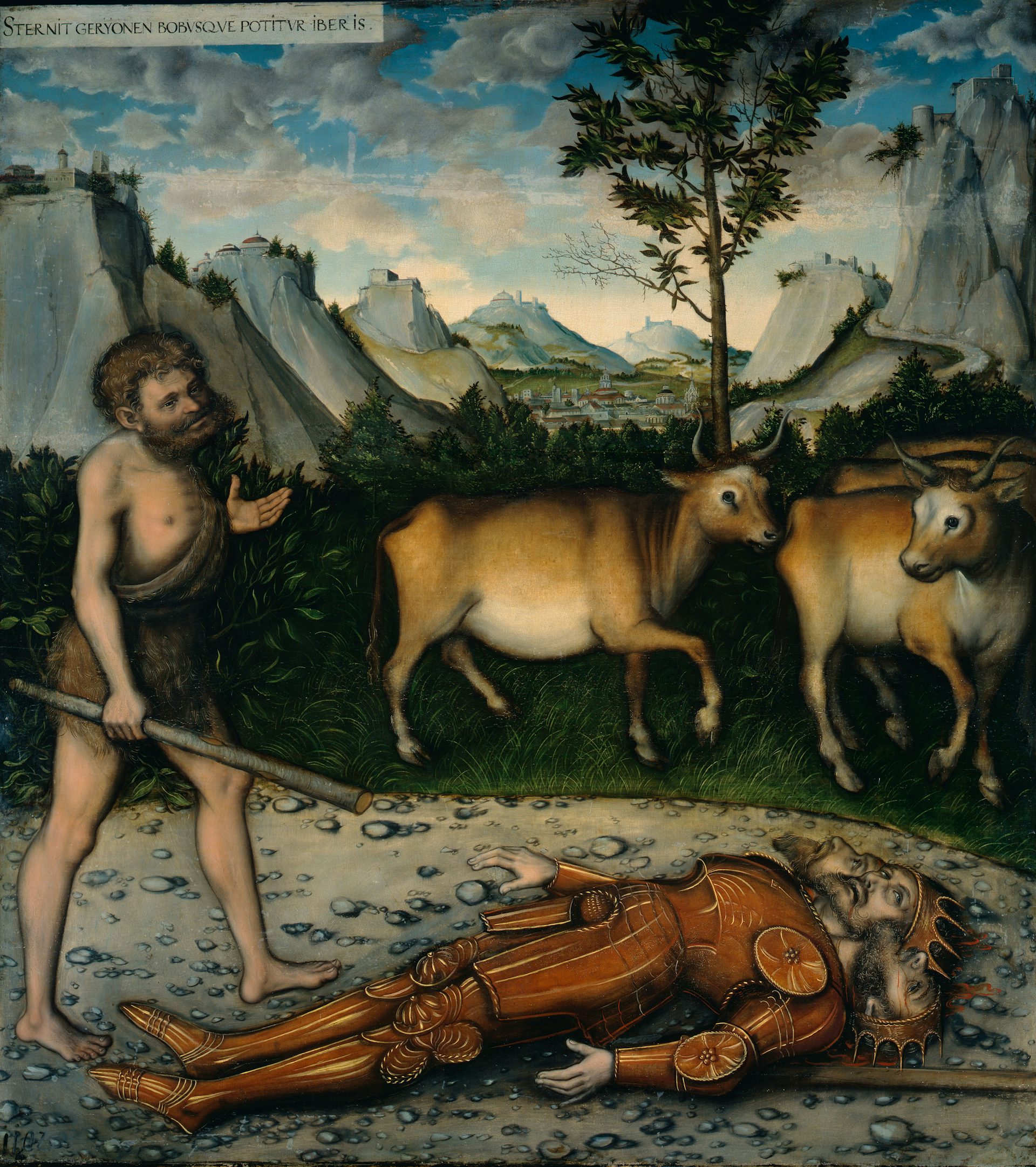Geryon

Hercules (center) battles Geryon (right) and his two-headed dog Orthus (bottom). Hercules kills Geryon and his dog by Cornelis Cort, after Frans Floris (ca. 1563–95).
RijksmuseumPublic DomainOverview
Powerful Geryon, son of the giant Chrysaor and the Oceanid Callirhoe, was a monster with three heads and three bodies who lived at the far edge of the world. With the help of his herdsman Eurytion and his two-headed guard dog Orthus, he kept a much-envied herd of cattle—so envied, in fact, that the hero Heracles was commanded to steal it as the tenth of his Twelve Labors. When Heracles arrived to carry out his task, Geryon fought bravely in defense of his property but was ultimately slain.
Etymology
The etymology of the name “Geryon” (Greek Γηρυονεύς, translit. Gēryoneús; also Γηρυόνης/Gēryónēs or Γηρυών/Gēryṓn) is uncertain. Popular or folk etymologies connected it to the Greek word γῆρυς (gêrys), meaning “voice, speech.”[1] Geryon’s name could thus be translated as something like “the roarer.”
But it is more likely that the name came from a Celtic root connected with cranes. Similarities can be found between Geryon’s name (especially its Etruscan form, Cerun or Gerun) and figures like Gerana, a crane-woman of Italian mythology, and Garanus, an obscure Italian hero.[2]
Pronunciation
English
Greek
Geryon Γηρυονεύς (translit. Gēryoneús), Γηρυόνης (translit. Gēryónēs), Γηρυών (translit. Gēryṓn) Phonetic
IPA
[GER-i-uhn] /ˈɡɛr ɪ ən/
Attributes
Locales
According to Hesiod's Theogony, our earliest source for Geryon’s myth, the monster lived in “sea-girt” Erytheia.[3] This mysterious land was usually thought to be somewhere at the edge of the world.
Later authors, trying to pinpoint Erytheia’s location, usually placed it in the far west. Most identified Erytheia with Gadeira (modern Cadiz) in Spain,[4] or said that Geryon lived by the Tartessus River (today known as the Guadelquivir).[5] But some authorities had very different ideas. One early writer, the historian Hecataeus of Miletus, placed Erytheia closer to home, in Ambracia on mainland Greece,[6] while the geographer Ptolemy wrote that Erytheia hailed from Mauritania in northern Africa.[7]

Aerial view of the Strait of Gibraltar.
VertounoirCC BY-SA 4.0Roman writers, on the other hand, made Geryon into a kind of Underworld demon and therefore located his home in the Underworld.[8]
Appearance
In the standard tradition, Geryon was a giant of a man with three heads and three bodies emerging from a single pair of legs.[9]
Earlier traditions, however, offered variations on this image. The poet Hesiod, for example, described Geryon as merely three-headed.[10] Stesichorus, another early poet, gave Geryon three bodies as well as three heads, while also adding six wings growing from six arms.[11] Ancient artists often represented Geryon as a mess of limbs and sometimes even showed him as three completely separate human figures (see below).
Geryon’s inordinately large number of limbs seem to have given him inordinate strength to match. Hesiod described him as “the strongest of all men.”[12] When fully armed, he presented a fearsome opponent, wearing a helmet on each of his heads, carrying a shield to cover each body, and wielding a spear in each arm.[13]
The Cattle of Geryon
Geryon was best known for his herd of cattle, which seem to have been particularly magnificent. According to the mythographer Apollodorus, they were distinguished by their red color.[14] Aside from this detail, however, ancient sources have little to say about the animals—except, of course, that they were impressive enough for Eurystheus, the king of Mycenae, to send Heracles to the other side of the world in order to steal them.
Iconography
In art as in literature, representations of Geryon evolved over time. In some images, he is shown with three heads growing out of one body;[15] elsewhere, he has three bodies and two sets of legs, or even three completely separate bodies;[16] on a few vase paintings, he even has wings (though usually only two wings, not six as in Stesichorus’ account).[17] By the fifth century BCE, however, it had become standard to depict Geryon with three bodies growing from one set of legs (as in literature).
Geryon was particularly popular in art during the sixth century BCE, likely due to the influence of a poem by Stesichorus called the Geryoneis (which now survives only in fragments). He was almost always depicted in connection with Heracles’ tenth labor, generally in battle with the hero. A few of these depictions were already famous in antiquity.[18]

Attic black-figure amphora (jar) showing the battle between Geryon (right) and Heracles (left). Attributed to Group E (ca. 540 BCE).
Metropolitan Museum of ArtPublic DomainRepresentations of Geryon (especially in vase painting) often show his guard dog Orthus or his herdsman Eurytion dead at his feet, while Geryon, wielding multiple spears and shields in his many hands, struggles with Heracles. Sometimes, a few of Geryon’s bodies are shown slumped over, apparently mortally wounded, while the others still put up a hopeless defense.[19]
Family
Family Tree
Parents
Father
Mother
- Chrysaor
- Callirhoe
Siblings
Brothers
Sister
- Cotys
- Minyas
- Chione (daughter of Callirrhoe)
Children
Daughter
- Erytheia
Mythology
Origins
Geryon may have originated as a Celtic mythical figure or god. This is suggested by the fact that he was known in northern Italy from an early period (a region occupied by the Celts) and continued to be popular there throughout ancient history. The Greeks likely became familiar with him as they expanded their trading links with the western Mediterranean.[25]
The ancient Greeks also had their own “rationalized” explanations for how the myth of Geryon first came about. According to Palaephatus, Geryon was a completely normal man who happened to come from a city called Tricarenia, meaning “three-headed.” With the passage of time, this led to the belief that Geryon himself had three heads.[26] According to Diodorus of Sicily, the name “Geryon” actually referred to three different chieftains, each with his own army, and each of whom Heracles defeated in single combat.[27]
Other explanations for the origin of the myth have also been suggested in modern times. Jan Schoo, almost as comically as Palaephatus, has attempted to connect Geryon’s cattle with a kind of red lichen produced on the volcanic island of Tenerife.[28] Others have more plausibly connected Geryon’s story with various mythical or folklore motifs, such as cattle raiding, the heroic quest, and the journey to the end of the world.[29]
The Tenth Labor of Heracles
Geryon’s sole appearance in Greek mythology is in connection with Heracles’ famous Twelve Labors. These were assigned to the hero by Eurystheus, the king of Mycenae, who in turn was advised by Heracles’ divine nemesis, Hera. Though these seemingly impossible labors were intended to destroy Heracles, they only added to his fame as he defied the odds and completed them one by one.
For his tenth labor (originally meant to be his final labor, according to most sources), Eurystheus sent Heracles to bring him the cattle of Geryon. The dangers of this labor lay less in the owner of the cattle than in the journey: to get to Geryon and his herd, Heracles would first need to reach the mysterious land of Erytheia, somewhere at the edge of the world.
The Journey to Erytheia
Heracles’ journey to (and from) Erytheia was highly eventful. Helios, the Titan god of the sun, let Heracles borrow his magical golden goblet to carry him across the vast sea (in some traditions, it seems that Heracles received the goblet after quarreling with or threatening Helios, while in others he borrowed the cup from the sea god Nereus rather than Helios).[30]

Tondo of a red-figure kylix showing Heracles sailing across the sea in the goblet of Helios. Attributed to Douris (ca. 480 BCE). From Vulci, Italy. Vatican Museums, Rome.
PompilosCC BY-SA 4.0In another tradition, Heracles’ journey to Erytheia took him first to the island of Crete, where he rid the place of wild animals.[31] He then traveled through North Africa, battling the giant Antaeus in Libya and the savage king Busiris in Egypt.[32]
At last, Heracles made the crossing to Erytheia through what is today called the Strait of Gibraltar. As he passed by, he created the two cliffs that rise on either side of the strait, which became known as the “Pillars of Heracles.”
Sources were divided, however, on whether Heracles created the strait by splitting the narrow strip of land that had until then connected Europe and Africa or whether he actually made the strait narrower to prevent monsters from entering the Mediterranean Sea from the Atlantic Ocean. Some also said that Heracles created his “pillars” later, during his return journey.[33]
The Battle
When Heracles finally reached Erytheia, he made quick work of Geryon. Though the monster was helped by his herdsman Eurytion, his two-headed guard dog Orthus, and his many limbs, he was no match for Heracles.
According to Apollodorus, Heracles promptly found Geryon’s herd, killed Orthus and Eurytion, and began driving the cattle away. But another herdsman, a man named Menoetes, saw what had happened and rushed to tell his neighbor Geryon. The monster armed himself for battle and set out to meet Heracles, but the hero killed him with a single well-aimed arrow.[34]

Hercules and the Cattle of Geryon by the workshop of Lucas Cranach the Elder (after 1537).
Herzog Anton Ulrich MuseumPublic DomainThe poet Stesichorus gives a surprisingly touching account of Geryon’s death. He describes how Heracles shot Geryon down with one of his arrows, poisoned with the blood of the Hydra:
and it cut through the flesh and bones by divine dispensation; and the arrow held straight on the crown of his head, and it stained with gushing blood his breastplate and gory limbs; and Geryon drooped his neck to one side, like a poppy which spoiling its tender beauty suddenly sheds its petals.[35]
With Geryon dead, Heracles drove the cattle back to Greece, though his return journey was even more eventful than the outward one. This voyage, described or alluded to by countless sources, took Heracles through Spain, the land of the Celts, the Alps, Italy, Sicily, and Thrace.[36] But Heracles at last reached Greece and delivered the cattle of Geryon to Eurystheus.
Worship
Geryon was worshipped in parts of Italy. In the northern Italian town of Patuvium, for example, he had an oracular temple.[37] He also had a temple in Agrium in Sicily.[38]
Pop Culture
Geryon still rears his head (or heads) in some modern adaptations of Greek mythology, including Rick Riordan’s Percy Jackson and the Olympians book series and the TV series Hercules: The Legendary Journeys. But Geryon is not as familiar today as some of Heracles’ other monstrous opponents, such as the Nemean Lion, the Hydra, and Cerberus.